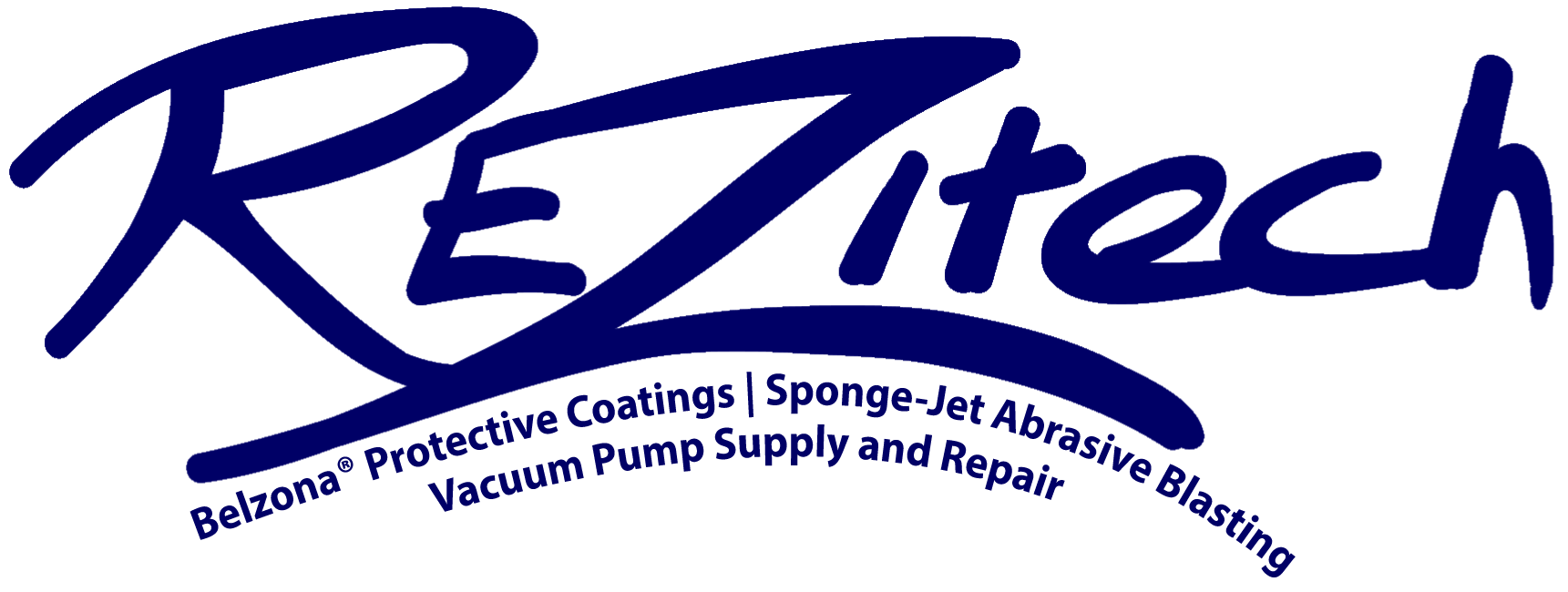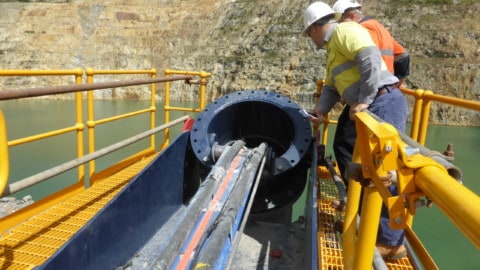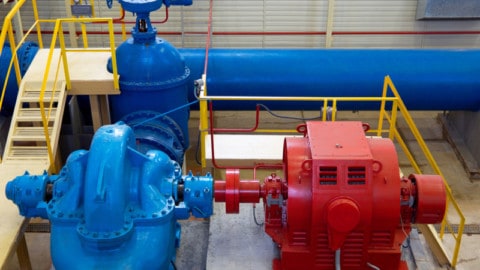By Imogen Hartmann, Journalist, Pump Industry magazine
Experts have determined that preventing carbon dioxide emissions from entering the atmosphere is a critical component of combating climate change. This is where carbon capture and storage (CCS) technology comes into the equation. Here, we break down how CCS works, the equipment and pumps that are used, and examine its role in the future management of global warming.
The International Energy Agency (IEA), the intergovernmental body focusing on energy security, climate change and air pollution, energy access and efficiency, says CCS technology has the potential to bring down global carbon dioxide emissions by almost a fifth at a cost of only 30 per cent of what it would otherwise take to tackle the climate crisis.
CCS is not a new concept, nor is it still under development; in fact, it is a proven technology that has been well developed, and made commercially available. CCS has been used by industries (particularly the oil and gas industry) for decades.
18 commercial scale CCS facilities are listed as operational by the Global CCS Institute across Norway, Canada, US, Saudi Arabia, Brazil and China. The Global CCS Institute records five more under construction, and another 20 at various stages of development worldwide.
An extensive scientific and engineering knowledge base of CCS has been developed (across a wide range of industries and geologies) through more than 100 pilot and demonstration projects.
It has been proven as a legitimate climate change mitigation measure by leading international authorities such as the Intergovernmental Panel on Climate Change (IPCC), the IEA, the UK Committee on Climate Change (CCC), and US EPA.
The CCS process and pumps
CCS refers to the process of capturing carbon dioxide (CO2), a greenhouse gas, from industrial processes such as major factories and power plants, and then transferring it to suitable locations where it can either be used or stored (typically deep underground).
Because of the similarities between fossil fuel extraction and CCS, pump technology used to inject natural gas liquids (NGL) into production fields (centrifugal pumps) and inject acid gas liquids back into the fields (high pressure pumps), can be applied to CCS activities.
Multistage pumps and hydraulic power recovery turbines can also be used in CCS processes at refineries, petrochemical and chemical manufacturing plants.
CCS also encompasses a range of other pump-related equipment such as boilers, compressors, blowers and turbines. The CCS process involves a chain of different technologies in four steps:
1. Capture
The CO2 is separated and captured at an industrial (natural gas, oil, coal or biomass) facility. The CO2 capture process can be achieved by using pre-combustion, post-combustion, or oxyfuel methods. In the capture phase of the CCS process, both single and multistage pumps can be used, depending on the application.
Pre-combustion
In the pre-combustion method, the CO2 capture occurs before combustion. By exposing the coal to high temperatures and high pressure in a gasifier, it is converted to syngas.
The syngas is converted into hydrogen and CO2 in a downstream shift reaction, allowing it to be captured, where it can then serve as fuel for generating energy.
High pressure pre-combustion processes, however, may be better suited to high-energy, multistage pumps, and cold applications can require pumps with low temperature materials and select sealing techniques. Pre-combustion equipment may include:
- Pump for cooling water circuits (burners)
- Pump for cooling water circuits (syngas)
- Pump for flue gas scrubbing
- Pump for feedwater and freshwater applications
- Pump for blackwater treatment
- Shut-off valve
- Check valve

Pre-combustion capture. Provided by Global CCS Institute.
Post-combustion
The post-combustion method refers to the process of extracting CO2 from flue gas through a combustion process. This method calls for several different variants, including physical and chemical methods for scrubbing the flue gas.
The flue gas is first ridded of its ash, nitrogen and sulphur oxides before being cooled. The flue gas is then put through a scrubber (absorber), where the CO2 is captured by a solvent. As the CO2-loaded solvent is then pumped through a desorber, it is readied for further treatment by adding heat to separate the CO2 from the solvent, where the solvent can then be returned to the process.
Post-combustion CO2 capture may call for a single stage pump system to circulate both rich and lean liquid solvents. Post-combustion equipment may include:
- Pump for flue gas scrubbing
- Pump for cooling-water circuits
- Pump for solvent handling
- Pump for solution transport
- Shut-off valve
- Check valve

Post-combustion capture. Provided by Global CCS Institute.
Oxyfuel
Deriving from the words ‘oxygen’ and ‘fuel’, the term oxyfuel refers to a capture method that is incumbent on coal being combusted with oxygen instead of the usual air. With the combustion air first being broken down into oxygen and nitrogen, the fuel burned with oxygen is
able to yield a higher concentration of CO2 in the fuel gas.
The ash, SO2, SO3 and other impurities are then removed from the flue gas and the gas is cooled to a low enough temperature that its water content condenses, where a very pure CO2 then remains to be captured, compressed, transported and either stored or further processed.
Oxyfuel equipment may include:
- Pump for cooling water circuits
- Pump for district heating
- Shut-off valve
- Check valve

Oxyfuel capture. Provided by Global CCS Institute.
2. Compression
Once the CO2 has been captured it is then compressed to a desired pressure for transportation. This can be achieved by using a gas compressor or by liquefying the CO2 at lower pressures by using refrigeration systems, which are then pumped to the desired pressure.
One benefit to the liquefaction approach is that less power is required for liquid pumps to raise pressure, and the process can be considerably less expensive than gas compressors. This method requires a careful assessment of the refrigeration process to maintain accurate system power accounting.
Diaphragm pumps and the acid gas challenge
A number of challenges are presented for pump systems when handling H2S (acid gas) – which is removed from CO2 in the CCS process from gas-treating plants.
Hydrogen sulfide, a compound of sulfur and hydrogen with the chemical formula H2S, is highly toxic and flammable, and poses several potential environmental hazards. H2S also has poor lubrication properties and high vapour pressure.
Conventional compression systems generally involve five compressor stages, and can face issues like corrosion (caused by decompression in packing and sealing elements), and a surge in electrical power demand and stages (due to high suction temperature).
Combined compression systems can marry stage compressors with a specially-designed, hermetically-sealed triplex diaphragm pump, which provides subcooling to liquid phase functionality.
The advantages of this combined method can include energy power saving and flexible operations, while the disadvantages include mass flow ≤ 150 t/h; suction pressure: ≥ ambient pressure; discharge pressure: ≤ 500 bar; and a cooling requirement depending on mixture (~25°C pure CO2).
Despite these limitations though, specially-designed diaphragm pumps can provide an innovative way to optimise the energy efficiency in the CCS compression phase.
Centrifugal pumps
A centrifugal pump solution offers several advantages when compressing and conveying supercritical fluid CO2. Using a centrifugal pump, circumvention is possible in the last compression stages, meaning less specific compression work is required, thereby saving energy.
The process occurs at low temperatures, so the heat losses are accordingly lower, and the material faces no thermal stress exposure. Centrifugal pumps can save up to 23 per cent of energy.

3. Transportation
After compression, the CO2 is then transported to a suitable geological site. The two forms of transport for moving CO2 long distances are via pipeline or ship.
It is widely regarded that pipeline transport is the most economical method for moving large volumes of CO2. To enable this, the CO2 is converted into a high pressure, super-critical fluid called dense phase. The CO2 is able to be pumped because in this phase it CO2 behaves more like a liquid than a gas.
Radially and axially split pumps are ideal for dense phase CO2 transportation. Regardless of whether the CO2 is being transported via pipeline or ship, high pressure pumps designed especially for such applications are needed.
4. Injection
The CO2 is now injected deep below the ground (depths greater than 800m) for long-term storage. By injecting the CO2 into subterranean rock strata, the greenhouse gases are prevented from entering the atmosphere.
This process can also unlock the tertiary recovery of crude oil or natural gas, as it increases the pressure prevailing in the oil reservoir and reduces the viscosity of the oil.
An economic solution in this case is called enhanced oil recovery (EOR), and it involves CO2 being injected into active oil fields to increase production.
Unusable saline aquifers, and depleted oil and natural gas reservoirs, can also function as suitable injection areas for the gas. Specially-engineered high pressure pumps are also needed for the underground injection of CO2.
There is some crossover of equipment for both the transportation and injection phase, which can include:
- Single and multistage pipeline and injection pumps
- High and ultra-high pressure barrel pumps for injection services
- Sealing solutions using liquid or dry gas seals
The entire exercise of CCS can be looked at as the oil and gas industry in reverse, whereby CO2 is stored within porous sandstone beneath thick capping layers rather than hydrocarbons being extracted from those same rocks where they have been stored for millions of years.
Pump solutions are essential in the capture, compression, transport and injection stages of the overall CCS process. Materials, wear parts, mechanical seals, and accurate calculations of performance factors are all critical considerations for CCS pump selection.
In the compression, transport and injection phases of CCS, there are a number of pump considerations including the impacts of temperature and density. Hydrotesting and mechanical seals can be beneficial in this regard.
A CCS timeline
On geoengineering and the CO2 problem, one of the first published papers to refer to what we now know as CCS, was published in 1977.
However, it took another 15 years before the field of CCS came to fruition. The below timeline outlines key moments in the CCS history:
- 1991: The International Energy Agency launches the Greenhouse Gas R&D Program
- 1997: The US establishes its own research program at the Department of Energy, where it invested $1 million per year. Today, that investment figure has inflated to $200 million a year
- 2005: The Intergovernmental Panel on Climate Change (IPCC) releases a Special Report on Carbon Dioxide Capture and Storage, thus establishing CCS as a viable climate mitigation option
CCS grew dramatically from 1990 to 2009. This is demonstrated by attendance rates at the Greenhouse Gas Control Technologies conference, the premier international meeting on CCS, where numbers grew steadily until 2009, when they began to wane. Key indications of growing interest in CCS technology during this time period included:
- Announcements of dozens of demonstration projects
- Increasing research and development activities in laboratories and pilot plants
- Developing innovative solvents to capture CO2 from exhaust gases
- The design, development and testing of processes that integrated power production and CO2 capture were designed, developed and tested
- Testing field for CO2 underground injecting, regulatory frameworks development and public outreach programs
By 2020, it was expected that 20 large-scale demonstration projects would be up and running and CCS would be considered commercial. But there were a number of challenges facing the uptake of CCS technology.
The safety and challenges of CCS
Once the CO2 is stored beneath the ground, geologists can use detailed modelling to help predict any potential movements of and the direction and distance it could travel if it was to do so.
The CCS process is generally considered safe because carbon dioxide is an inert gas that exists naturally in the atmosphere, and because over time, the CO2 is further secured as it mineralises or is dissolved into saline water contained within the storage reservoir.
However, analysing and risk management is a crucial element of a CCS project, which involves strict compliance with relevant laws and
regulatory requirements, as well as ongoing research into potential hazards like earthquakes.
Another potential barrier to CCS uptake is a lack of market establishment. While other low-carbon technologies such as renewables and nuclear serve multiple purposes, and therefore service different markets, CCS has only one purpose: to reduce CO2 emissions.
While the participation of industry, such as electric utilities and oil companies, is critical in developing CCS, markets for
the technology are still uncertain.
This means that a CCS market establishment could be reliant on greenhouse gas emission-reducing climate policy. Another challenge of CCS in Australia is that the technology requires very specific geology to work, which, although Australia is credited with having some of
the best storage basins in the world, are not always convenient for Australia’s coal and gas-fired power plants.
Future development and opportunities
In late 2020, the Federal Government noted CCS as a priority technology in its technology roadmap, alongside “clean” hydrogen, energy storage, “low-carbon” steel and aluminium.
In September, the Federal Government earmarked $50 million for the development of CCS projects associated with power generation, heavy industry, hydrogen and gas production.
A discussion paper released ahead of the roadmap stated that Australia’s potential for large-scale CCS “is already of interest to some potential overseas markets looking to produce low-emissions hydrogen from coal and gas”.
Australian Energy Council Chief Executive, Sarah McNamara, said the federal focus on CCS for gas and hydrogen production was “sensible”, representing areas that were “realistic opportunities for this technology”.
“Previous efforts to develop CCS to allow retro-fitting of coal-fired power stations have not been commercially successful,” Ms McNamara said.
Several research and demonstration CCS projects have commenced or been announced in recent years, including:
- Southwest Hub (Western Australia)– collecting and analysing data and samples from the Lesueur Sandstone formation, to test its feasibility as a carbon dioxide storage reservoir
- CarbonNet (Victoria) – investigating the potential for a large-scale CCS network in the Gippsland region of Victoria
- Otway Geological Storage and Monitoring Demonstration Project (Victoria) – Australia’s first demonstration of deep geological storage
- Australia-China Post Combustion Capture Feasibility Study Project (international) – the centrepiece of the Australia-China Joint
Coordination Group on Clean Coal Technology - Cooper Basin CCS project (northern South Australia) – Santos and BP have entered an agreement to bury up to 20 million tonnes of carbon each year in the Moomba gas fields
- Chevron’s Gorgon gas facility (Western Australia) – Australia’s largest CCS operation
Although CCS isn’t a substitute for clean energies like solar, wind, and pumped hydro, it does offer the potential to reduce greenhouse gas emissions substantially.
CCS doesn’t capture CO2 entirely, and therefore is an imperfect system, however as coal and gas-fired power plants (and polluting industries) aren’t going to be shut down overnight, experts agree that it may be a suitable vehicle in the transition to a clean energy system, and in the mitigation of global warming.




















